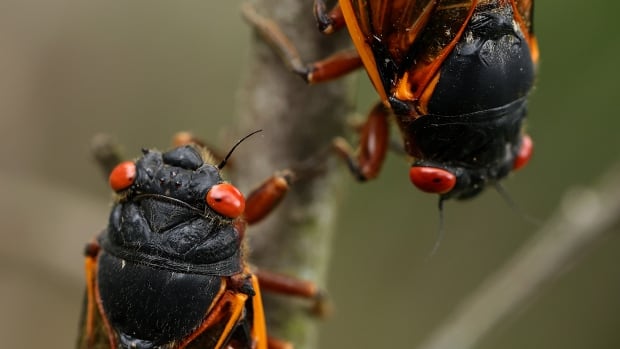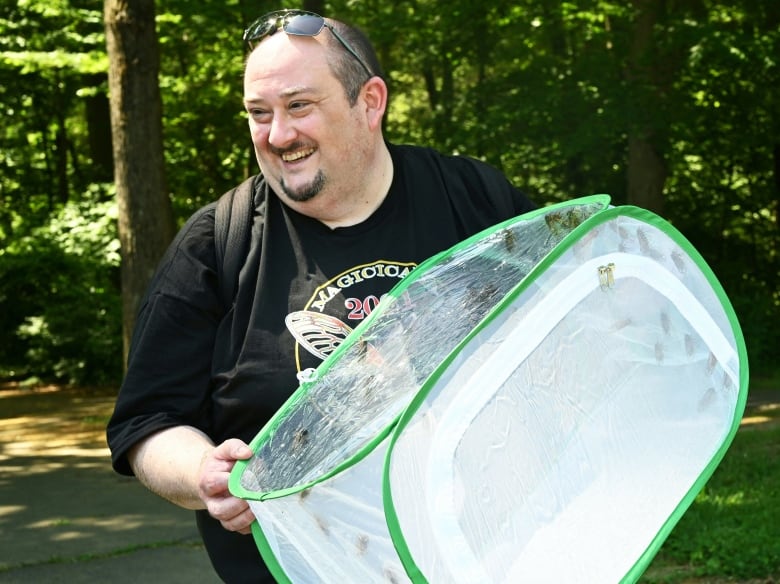
As It Happens6:37So long, solar eclipse. An even rarer phenomenon is about to take over the skies
Floyd Shockley is planning a road trip to witness a rare natural event that will darken skies across much of the United States — a convergence not of celestial bodies, but of two massive broods of flying, screaming, lustful insects.
This spring, two broods of cicadas, totalling more than a trillion, will emerge from the earth in search of mates and blanket huge swaths of the U.S. for months.
“A solar eclipse is absolutely a cool event, right? But it’s actually in a much smaller area than the cicadas are going to cover,” Shockley, an entomologist with the Smithsonian National Museum of Natural History in Washington, D.C., told As It Happens host Nil Köksal.
“And we have solar eclipses actually more frequently on Earth than these dual emergences. So this is an even rarer event than the solar eclipse.”
Tasty snacks for wildlife
There are seven species of cicadas in North America that are periodical, meaning they spend more than 99 per cent of their lives dwelling underground as nymphs before emerging all at once to moult, mate, lay eggs and then die.
This spring, two multi-species groups of cicadas, known as broods, will come out for their end-of-life bacchanalias.
Places where people like to go to hang out … are going to be filthy with cicadas.– Floyd Shockley
Brood XIII, which emerges every 17 years, and Brood XIX, which comes out every 13 years, will overlap for the first time in 221 years.
All seven periodical species will be visible this year, which won’t happen again until 2037.
“It’s going to be really great if you’re an entomologist,” Shockley said. “And it’s going to be even better for wildlife. This is a really abundant food source, so birds and mammals and reptiles are going to be going crazy enjoying all these cicadas.”
Cicada nymphs only leave their underground home when the soil warms to about 17.7 C, he said. “That is the cue for them to start digging their way up to the surface.”
Once they emerge, the nymphs crawl up hard surfaces, like tree trunks or telephone poles, then moult into winged adults.

Some have already come out in Virginia, Shockley said, and the first big wave in the coming weeks is expected in Louisiana, Mississippi, Alabama and Georgia.
In May and June, Shockley says, they’ll start coming out in the midwestern U.S., and then finally in the northern part of the country.
They live about four to six weeks after they moult, so the last ones will be lucky to make it to July. All together, the lovelorn insects will cover 17 states.
Shockley plans to be in Illinois for late May and early June, when both broods will be active in different parts of the state simultaneously.
“So literally just a few miles away from one another … you’ll be able to hear all seven species singing their individual song in just a short distance,” he said.
“It’s a really exciting opportunity, and it’s one that many of us won’t ever get to see again.”
University of Connecticut evolutionary biologist John Cooley agrees.
“There’s nowhere else in the world where it’s possible to see anything at all like this,” he said.
What to expect
Cicadas are about 2.5 to five centimetres long, with sturdy bodies, bulging compound eyes and membranous wings.
If you’re in the coverage zone, Shockley says you’ll likely find them near the ground in the early morning. As it warms up during the afternoon, they’ll “start flying around looking for a really great perch to start singing from.”
That “singing” is actually a mating call the males make using special organs on their abdomens.
“It’s a male chorus all going off all at once with one purpose — to woo the ladies,” Shockley said.
If interested, females will respond with wing flicks, which also make a sound.

Underground, the nymphs feed on plant juices from the roots of deciduous trees and shrubs. So anywhere there are a lot of trees, Shockley says, there will be a lot of cicadas.
“Places where people like to go to hang out in the spring and summertime, like parks and things, are going to be filthy with cicadas for about two months. They’re going to be out there screaming and flying and doing their thing,” Shockley said.
In some places, he says, the skies will be downright thick with them.
“When we had Brood X here in the Washington, D.C., area [in 2021], you know, when you were driving along the Beltway, they were pinging off of your windshield like you were driving through a hailstorm.”
‘They’re very gentle’
Shockley says he understands that not everyone is as excited as he is about swarms of screaming insects.
“It can definitely be scary, especially if you have a natural aversion or are afraid of bugs,” he said.
Still, he urges people to remember they pose no threat.
“They’re very gentle. They don’t bite. They don’t harm plants,” he said. “I think they definitely get a bad rap.”
Whatever you think of them, Cooley says cicadas deserve our respect.
“I always counsel people to treat them with the respect and awe due to such remarkable creatures,” Cooley said.
“The species have a long history — millions of years. And that history is much longer and deeper than the history of the landscapes and forests in which they live — on the order of tens of thousands of years. So the cicadas are a natural part of the ecosystem.”